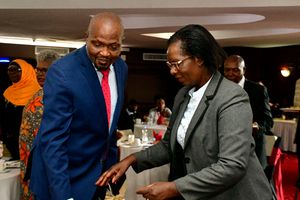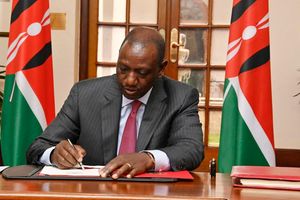
Treasury Cabinet Secretary Prof Njuguna Ndung'u displays the Budget briefcase ahead of his speech in parliament in Nairobi, Kenya on June 15, 2023.
Kenya’s projected expenditure plans for the 2024/25 financial year are expected to reduce by Sh350 billion owing to the contracting tax net flows as the Treasury prepares to present to the National Assembly the government’s printed budget estimates for tabling in the House by tomorrow.
The 2024 Budget Policy Statement (BPS) approved by the National Assembly in March this year, had projected Sh4.2 trillion as the expenditure plan of President William Ruto’s Kenya Kwanza administration for the 2024/25 financial year.
To finance the budget, the 2024 BPS had projected revenue collection for the 2024/25 financial year at Sh2.95 trillion up from the current Sh2.62, representing a 14 per cent growth.
The projected budget leaves a fiscal deficit of Sh703.9 billion, about 3.9 per cent of the country’s Gross Domestic Product (GDP), to be financed through domestic borrowing of Sh377.7 billion and foreign market borrowing of Sh326 billion.
However, the Budget and Appropriations Committee (BAC) of the National Assembly and the Parliamentary Budget Office (PBO) have warned that the failure to hit the right revenue targets presents the government with no other alternative but to reduce its projected expenditure plans for the next financial year.
This is unless the government goes big on taxation in the Finance Bill 2024, for instance, the planned introduction of motor vehicle circulation tax and withholding tax on farm produce, among others,.
The 2024/25 financial year starts on July 1, this year.
The BAC report on the consideration of the 2024 BPS as adopted by the House in March this year, shows that by December 2023, six months into the current financial year, the government had a revenue shortfall of Sh178 billion.
This even as the PBO projects Sh300 billion in missed revenues for the current financial year.
“The committee noted with concern that the revenue raising measures contained in the 2023 BPS and Finance Act 2023, have not achieved the revenue growth targets,” the BAC report on the 2024 BPS reads.
“If the revenue target for the 2023/24 is missed by a big margin that would indicate similarly, the 2024/25 financial year target is way too high,” the committee warns.
The Parliamentary Budget Office (PBO) in its quarterly economic and fiscal upgrade paper for July-September 2023 before Parliament, predicted Sh300 billion in missed revenue targets this fiscal year if the revenue performance trend endures.
“If the performance rate follows the same trend for the rest of the fiscal year, then the annual target is likely to be missed by Sh300 billion,” the PBO document warns even as it attributes this to the delay in the implementation of the revenue raising measures contained in the Finance Act 2023.
This came as the latest data from PBO, which advises Parliament and its committees on fiscal matters, indicates that the figure could go as high as Sh350 billion in missed revenue target for the present year.
Tomorrow, April 30, 2024, is the deadline for tabling the national government’s budget estimates for consideration by the National Assembly.
The estimates though excludes those of Parliament and the Judiciary.
Section 37 (2) of the Public Finance Management (PFM) Act of 2012, states; “the Cabinet Secretary shall submit to the National Assembly by April 30 in that year, the budget estimates excluding those for Parliament and the Judiciary.”
To be tabled alongside the budget estimates is the Finance Bill 2024, which provides for the revenue raising measures to finance and therefore, implement the budget as well as the 2024 Medium-Term Debt Management Strategy (MTDMS) paper.
The adoption of the BAC report on 2024 BPS by the National Assembly in March, formed the basis for the preparation of the budget estimates.
But even as it warned the government on dangers of missed revenue targets, the committee chaired by Kiharu MP Ndindi Nyoro, approved Sh2.5 trillion as the projected expenditure for the Executive in the next financial year up from Sh2.46 trillion in the current financial year.
The committee also approved Sh43.62 billion in allocation to Parliament up from the present Sh41.62 billion and Sh23.7 billion to the Judiciary up from Sh22.8 billion in the current financial year, Sh8.6 billion for the Office of the Auditor-General and Sh391.12 billion in equitable share to the counties.
The allocation to counties is a marginal improvement to the Sh385.42 billion in the current financial year although Senators are pushing for Sh415 billion as per a report on the Division of Revenue Bill 2024 passed by the National Assembly.
The Consolidated Fund Services (CFS) projected allocation has increased by Sh110 billion from the Sh1.13 trillion allocated presently.
The committee went ahead to approve the allocation of Sh48.2 billion in county additional allocation and Sh7.9 billion to the Equalisation Fund as it set a ceiling of Sh3.55 billion as the arrears to the fund.
The main drivers for the increased budget include an additional Sh89.9 billion on interest payment on public debt as well as Sh70.7 billion increase in development expenditure.
The BAC and PBO revelations mean that the government will continue to face headwinds financing its development obligations as public debt hits over Sh11 trillion.
In such instances of reducing the country’s expenditure projections, it is the development budget that suffers.
This means that even as the government, for instance, plans expenditures under infrastructure, what would have gone towards repairs of the roads damaged by the ongoing heavy rains in the country will likely reduce.
The government is also mulling to transition all its about one million public service staff from permanent and pensionable (PnP) terms to contract and pensionable (CnP) terms as it seeks to reduce its spiralling wage bill of about Sh1.1 trillion a year and therefore cut the recurrent expenditure.
To achieve a higher revenue growth, the government has published the Medium-Term Revenue Strategy (MTRS), whose objectives include raising revenue as a share of GDP from 14.3 per cent to 20 per cent.
The government also planned to increase tax compliance rate from 70 per cent to 90 per cent as it targeted to increase investment to GDP ratio from 19.3 per cent to 25.7 per cent by 2026/27 for sustained growth.
But with the likelihood of failing to meet these targets high, it means the government has to repurpose its expenditure plans through cuts.
The PBO, using data from the National Treasury, indicates that development expenditure, which is critical in stimulating the country’s economic growth, declined by Sh31.6 billion, which is 4.2 per cent from 10 per cent recorded in the same period in 2022.
The net effect of this is that most government agencies received zero disbursements for development with disbursements to the 47 devolved units averaging Sh61.1 billion, about 8.2 per cent, “the lowest since quarter one disbursement in 2021.”
Other than development, the PBO document shows that ministerial recurrent expenditures in the first quarter of the current financial year declined by Sh268.1 billion, about 36 per cent from 40.6 per cent in the same period last year.
The highest releases, Sh75 billion, were, however, towards the education sector, specifically for the Teachers Service Commission (TSC) to cater for the payment of salaries of teachers, and the agencies in charge of security matters.
With the country’s public debt on an upward trajectory, it is not clear how it will be financed in the wake of a wobbly performance by Kenya Revenue Authority (KRA).
The PBO document shows that KRA missed its tax revenue collection target for the first quarter of the current financial year by Sh72.5 billion.
The first quarter target is set based on the annual tax revenue target of Sh2.57 trillion required to finance this financial year’s Sh3.6 trillion budget.
Although the revenue during the same period grew by 7.9 per cent from the previous year, PBO notes that it is a drop compared to an average of 13 per cent growth in previous years.
The PBO document further indicates that all tax revenue categories as contained in the Finance Act recorded below target performance for the period under review.
For instance, income tax missed its projections by Sh35.5 billion, mainly due to below-target collection of taxes from employment income (PAYE) by Sh16.1 billion.
Consumption based taxes also performed dismally, falling short by Sh33.4 billion with VAT missing the target by Sh12.6 billion, excise duty by Sh12.5 billion and import duty by Sh8.4 billion.
“Despite the shortfall, all revenue categories registered growth from previous year except import duty, which declined by 1.6 per cent on the backdrop of shrinking imports,” reads the PBO document.
This comes as the country’s economic revival looks volatile with public debt continuing to escalate.
As at the end of August this year, the public debt stood at Sh10.52 trillion — Sh4.81 trillion and Sh5.71 trillion in domestic and foreign debt, respectively.
The public debt escalation was specifically driven by a Sh1.62 trillion increase between June 2022 and June 2023, the highest increase ever in Kenya’s public debt on record.
The increase included Sh503.02 billion in domestic debt and Sh1.12 trillion in external debt partly due to the impact of the exchange rate on both new borrowing and external debt stock.












